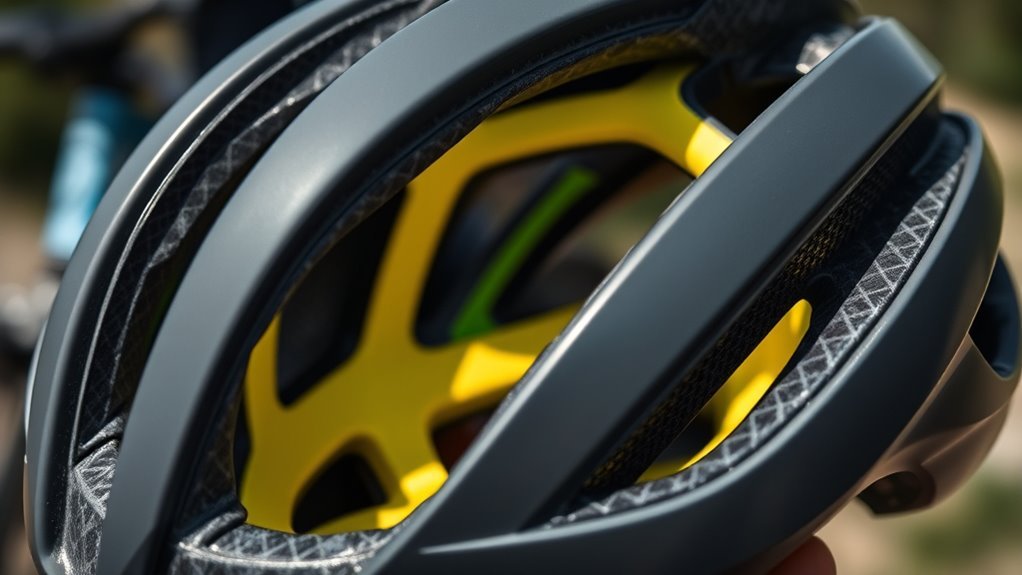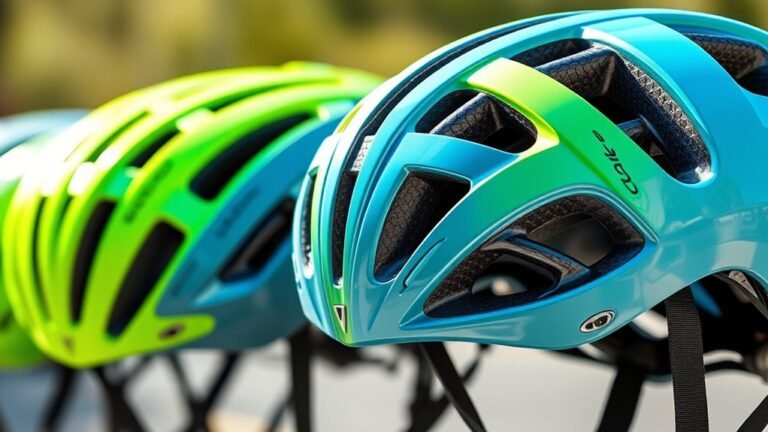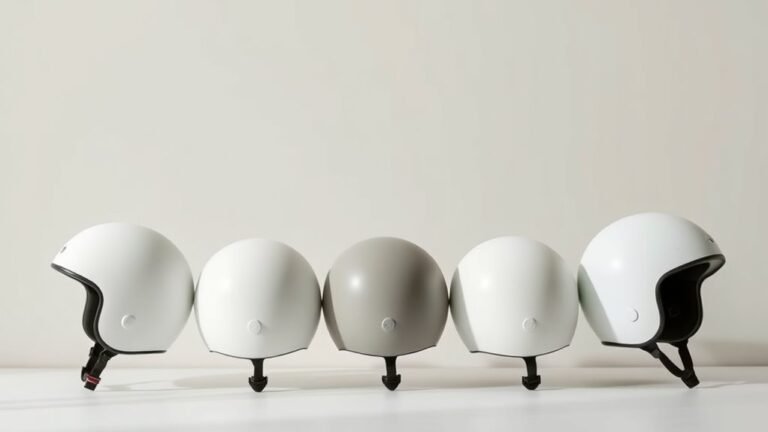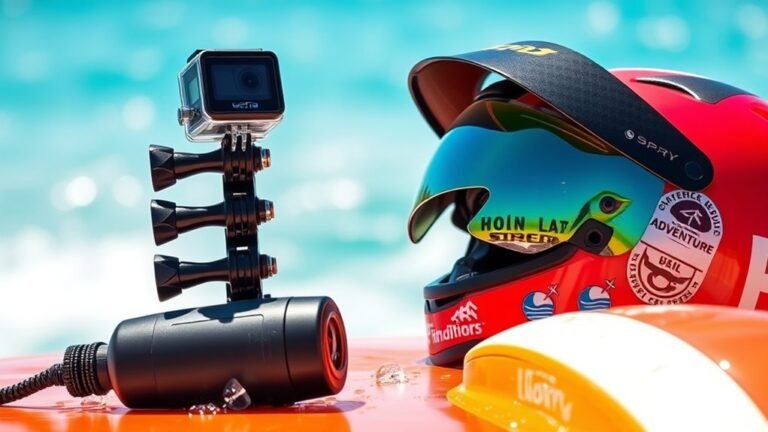The Science Behind MIPS Technology in Bicycle Helmets
MIPS technology in bicycle helmets is designed to reduce rotational forces during impacts, enhancing your safety. It achieves this through a low-friction layer that allows the helmet’s outer shell to slide upon impact, thereby mitigating forces that can strain your brain. Compared to traditional helmets, MIPS provides improved energy absorption, effectively managing impact forces. As helmet safety standards evolve, MIPS stands out in real-world testing. Discover how this innovative technology can greatly improve your protection on the road.
Understanding MIPS Technology
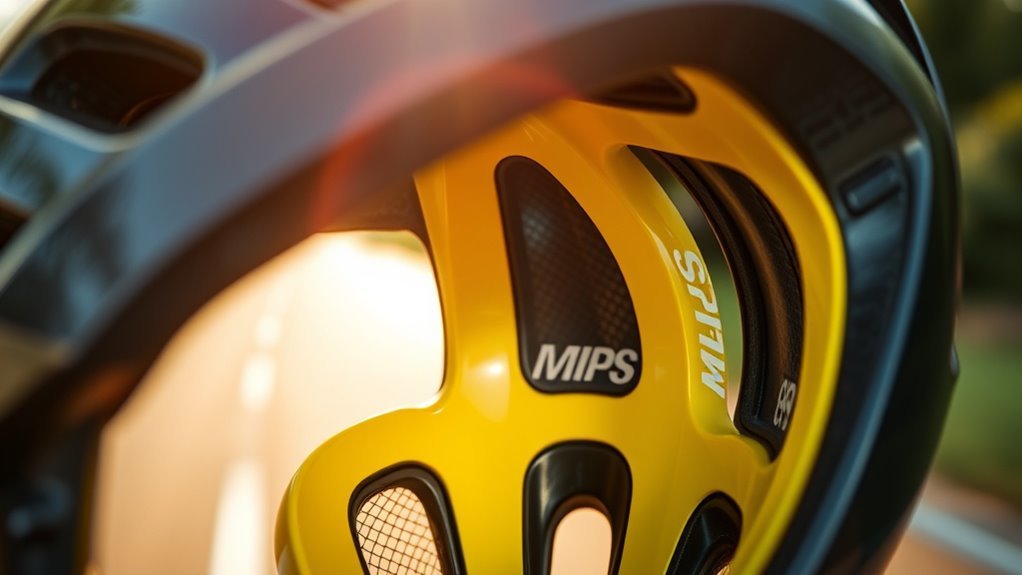
As you explore the world of bicycle safety, it’s essential to understand MIPS technology, which stands for Multi-directional Impact Protection System. This innovative approach in helmet design considerably enhances your protection during falls, as it reduces rotational forces that traditional helmets may not adequately address. MIPS benefits are particularly evident in real-world crash scenarios, where impacts often occur at angles. By allowing the helmet’s outer shell to rotate slightly upon impact, MIPS technology helps dissipate energy more effectively, minimizing the risk of brain injuries. This advancement is a demonstration of the commitment to safety while preserving your freedom to ride. Choosing a helmet equipped with MIPS technology is a proactive decision to enhance your cycling experience without compromising on protection.
The Mechanics of Impact

When you experience an impact while cycling, understanding how rotational forces interact with your helmet is essential. MIPS technology enhances the energy absorption mechanism to manage these forces effectively, reducing the risk of brain injury. By analyzing the mechanics of impact, you can appreciate how these innovations work to protect you during a fall.
Rotational Force Management
While many people focus on the direct impact forces during a bicycle accident, it is crucial to understand how rotational forces can also lead to serious injuries. When you fall, your head may rotate upon impact, creating rotational dynamics that can strain the brain and result in concussions. MIPS technology addresses this by incorporating a low-friction layer within the helmet, allowing it to slide during an impact. This sliding mechanism effectively aids in force mitigation, reducing the rotational forces transferred to your head. By minimizing these forces, MIPS helmets help protect against the potentially devastating effects of rotational injuries. Understanding this aspect of helmet design can empower you to make informed choices about your safety while enjoying the freedom of cycling.
Energy Absorption Mechanism
The energy absorption mechanism in bicycle helmets is a critical factor in protecting your head during an impact. This mechanism relies on materials engineered to dissipate energy effectively, reducing the force transmitted to your skull. When you experience an impact, the helmet’s outer shell absorbs initial shock, while the inner foam layers compress to manage impact dynamics. This multilayer approach enhances energy absorption, allowing the helmet to deform and spread out the forces over a larger area. Advanced materials, such as expanded polystyrene (EPS) and polycarbonate, improve performance by balancing weight and protection. Understanding these dynamics can empower you to make informed choices, ensuring your safety while enjoying the freedom of cycling.
Rotational Forces and Their Effects
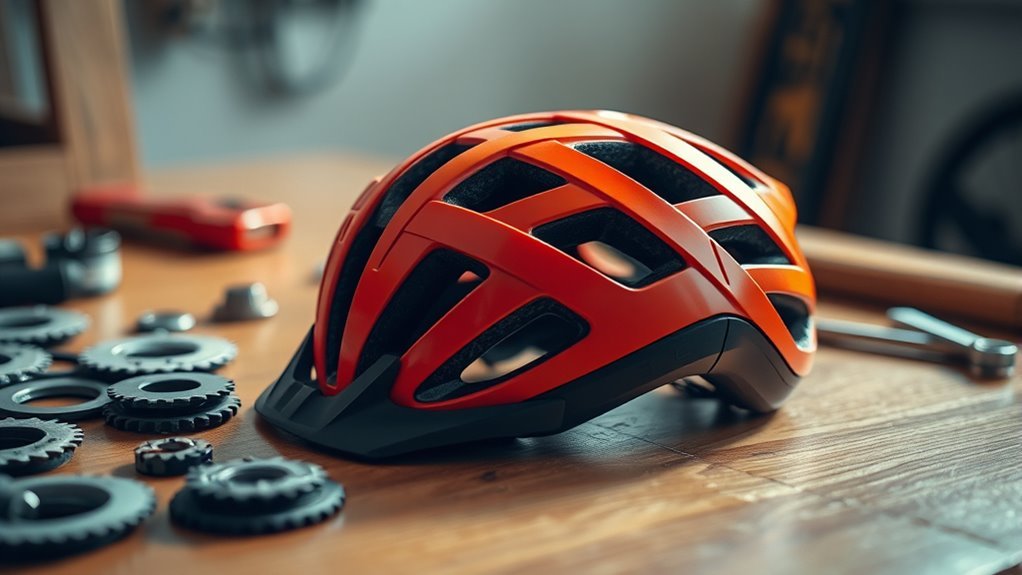
Although many cyclists focus primarily on linear impacts when considering helmet safety, rotational forces play a critical role in head injuries during falls or collisions. These forces can cause rotational injuries by twisting the brain within the skull, potentially leading to severe damage. The force dynamics at play during a crash can result in the helmet rotating on your head, exacerbating the risk of concussions and other traumatic brain injuries. Understanding how these rotational forces operate is essential for evaluating helmet safety. Increasingly, helmets with advanced technologies, like MIPS, are designed to mitigate these forces, allowing you to ride with more confidence. By acknowledging the importance of rotational forces, you empower yourself to make informed choices about your safety on the road.
How MIPS Works
To understand how MIPS (Multi-directional Impact Protection System) works, it is crucial to explore its design and functionality. MIPS technology enhances helmet safety by addressing rotational forces during impacts. Here’s how it operates:
MIPS technology enhances helmet safety by effectively addressing rotational forces during impacts.
- Low-friction layer: It allows the helmet to rotate slightly upon impact.
- Multi-directional movement: This reduces the force transmitted to your brain.
- Adjustable fit: It adapts to various head shapes for better protection.
- Enhanced energy absorption: MIPS effectively dissipates impact energy.
- Proven effectiveness: Extensive testing supports MIPS advantages in preventing injuries.
Benefits of MIPS in Bicycle Helmets
When considering helmet safety, you can’t overlook the benefits of MIPS technology in bicycle helmets. The MIPS advantages lie in its ability to reduce rotational forces during impacts, which can considerably lower the risk of brain injuries. This innovative design enhances your protection without compromising comfort or style, allowing you the freedom to ride confidently.
Here’s a comparative look at the benefits of MIPS helmets:
| Feature | MIPS Technology | Traditional Helmets |
|---|---|---|
| Rotational Protection | Yes | No |
| Impact Absorption | Enhanced | Standard |
| Weight | Similar | Similar |
Comparing MIPS Helmets to Traditional Helmets
While both MIPS helmets and traditional helmets aim to protect cyclists, their underlying technologies differ considerably in how they manage impact forces. MIPS technology offers several advantages that can enhance your safety on the road.
MIPS helmets significantly improve impact force management, enhancing cyclist safety compared to traditional helmets.
- Rotational Force Reduction: MIPS helmets reduce rotational forces during an impact.
- Enhanced Energy Absorption: The inner layer allows for better energy dispersion.
- Improved Comfort: MIPS systems can increase airflow, promoting comfort.
- Better Fit: MIPS helmets often feature adjustable designs for a snug fit.
- Proven Effectiveness: Studies suggest MIPS helmets can lower the risk of head injuries.
When you weigh these MIPS advantages against traditional helmets, you’ll see significant differences that matter for your freedom and safety while cycling.
The Evolution of Helmet Safety Standards
You might find it interesting how helmet safety standards have evolved over the years, reflecting advancements in our understanding of injury prevention. Historically, regulations were minimal, often focusing solely on impact resistance, but modern testing methods now include various factors like rotational forces. This evolution underscores the importance of continual improvement in helmet design and safety features, as seen with technologies like MIPS.
Historical Safety Regulations
As advancements in bicycle safety have evolved, so too have the regulations governing helmet standards to guarantee rider protection. Understanding the helmet regulations history is essential for appreciating the safety standard evolution that’s taken place over the years.
- The early 1970s saw the first helmet standards introduced by organizations like ANSI.
- The Snell Memorial Foundation established more rigorous testing in the late ’80s.
- In 1999, the Consumer Product Safety Commission (CPSC) set mandatory standards in the U.S.
- International standards like EN 1078 emerged, creating a global framework.
- Recent years have brought attention to rotational impact protection, prompting further refinement.
These changes reflect a commitment to rider safety and the ongoing quest for ideal protection on the road.
Modern Testing Methods
With the rise of new technologies and a deeper understanding of impact dynamics, modern testing methods for bicycle helmets have greatly evolved, enhancing rider safety. These methods now focus on simulating advanced impact scenarios, providing a more accurate assessment of a helmet’s performance in real-world conditions. Testing protocols have shifted from simple drop tests to incorporating rotational forces, reflecting the complexity of actual accidents. This shift guarantees that helmets not only withstand direct impacts but also maintain durability under varying conditions. By utilizing high-speed cameras and sophisticated sensors, manufacturers can gather precise data, leading to improved designs that prioritize both safety and comfort. As a rider, understanding these advancements empowers you to make informed choices for your protection.
Real-World Testing of MIPS Technology
Although MIPS technology has garnered significant attention for its potential to reduce rotational forces during impacts, real-world testing is essential to validate its effectiveness. In various real-world scenarios, researchers have examined how MIPS helmets perform under diverse conditions, providing valuable insights into their protective capabilities.
Consider these key aspects of real-world testing:
- Crash simulations that mimic common biking accidents
- Data collection from helmet wearers involved in actual incidents
- Comparisons between MIPS and traditional helmet designs
- Evaluations of helmet performance across different speeds and angles of impact
- Long-term studies observing injury rates among MIPS users
These findings help you understand how MIPS technology enhances safety, ensuring you can ride freely, knowing your helmet’s performance is backed by rigorous testing.
Choosing the Right MIPS Helmet for Your Needs
How do you determine which MIPS helmet best suits your biking needs? Start by evaluating the helmet fit—ensure it sits snugly without pinching, allowing for comfortable wear during long rides. A proper fit greatly enhances safety and performance, so don’t compromise on this aspect. Next, consider your style preferences; MIPS helmets come in various designs, from sleek road styles to robust mountain options. Think about where you’ll ride most often, as this can influence your choice. Look for additional features like ventilation and visor attachments that align with your biking lifestyle. Ultimately, balance safety, comfort, and personal style to find a MIPS helmet that offers both protection and the freedom to enjoy your rides.
Frequently Asked Questions
Are MIPS Helmets More Expensive Than Traditional Helmets?
Yes, MIPS helmets tend to be more expensive than traditional helmets. This cost reflects the advanced technology designed to enhance helmet safety. MIPS benefits include improved protection against rotational forces during impacts, which can greatly reduce the risk of brain injuries. While you might pay more upfront, investing in a MIPS helmet can provide greater peace of mind, knowing you’re better protected during your rides, allowing you to enjoy your freedom on two wheels.
Can MIPS Technology Be Added to Existing Helmets?
You can’t easily add MIPS technology to existing helmets through retrofitting or modifications. MIPS is specifically designed during manufacturing to guarantee peak performance in impact scenarios. Trying to retrofit could compromise the helmet’s integrity and safety standards. While it’s tempting to enhance your gear, investing in a new helmet with built-in MIPS technology assures the protection you need. So, for true safety and freedom while riding, consider upgrading to a MIPS-certified helmet.
How Do I Know if My Helmet Has MIPS?
To know if your helmet has MIPS certification, check for a label or sticker inside the helmet indicating MIPS technology. Look for features like a low-friction layer between the foam and the outer shell, designed to reduce rotational forces during an impact. If you can’t find any indicators, consult the manufacturer’s website or product specifications. Ensuring your helmet meets safety standards is vital for your freedom and safety while riding.
What Is the Lifespan of a MIPS Helmet?
If you’re like Sarah, who crashed while biking downhill, knowing your helmet’s lifespan is vital. MIPS helmets typically last about 3 to 5 years, depending on use and storage conditions. After any significant impact, it’s essential to replace your helmet, regardless of its age. Regularly checking for wear and ensuring compliance with current safety standards can help maintain protection. Prioritizing your safety means understanding when it’s time for a helmet replacement.
Are MIPS Helmets Heavier Than Standard Helmets?
MIPS helmets typically weigh about the same as standard helmets, though some might feel slightly heavier due to the added technology. However, the MIPS benefits, including enhanced protection against rotational forces, often outweigh any minor weight difference. When you’re riding, the peace of mind from knowing you’re better protected can far surpass concerns about helmet weight. Ultimately, choosing safety should be a priority, allowing you the freedom to ride confidently.
